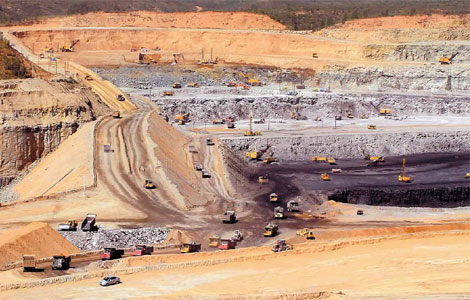Severe shortages ambush a 'gasified' China
Updated: 2013-11-14 20:19
(Xinhua)
|
|||||||||||
JINAN - China always grapples with gas shortages during the heating season, but the problem is expected to worsen this winter, as ambitious anti-pollution drives in many Chinese cities have become "guzzlers" of the scarce resource.
China's top natural gas producer, PetroChina, cut gas supplies on Tuesday to Cangzhou Dahua Group Co., Ltd., a major chemical fertilizer maker in north China's Hebei Province, according to an official announcement.
Suspension of gas supply to industrial users has been a common solution for years to ensure that residential users and public transportation are not left short in peak gas-consuming seasons.
However, suppliers have continued to provide gas to enterprise users in order to benefit economically, despite government regulations.
"This winter, such rule-breaking operations are not easily spotted," said a company manager, who refused to disclose his name when discussing the matter.
Wang Xiaokun, an analyst with chem99.com, a Shandong-based commodity information platform, said the output of petrochemical enterprises in China's central and northwest provinces has been or will be affected by diminishing gas supplies.
A gas supply coordination meeting held in October by the National Development and Reform Commission (NDRC), China's top economic planner, pointed out that cities such as Beijing, Shijiazhuang and Urumqi have started to see tensions in gas supplies during the consumption off-season for the first time.
Two notices issued by the NDRC last Monday banned construction of gas-fired power plants that have not secured full gas supply.
Insufficient gas supply has also brought inconvenience to local life in some provinces.
Even with a planned supply of 3.385 billion cubic meters (bcm) this winter, east China's Shandong Province will still fall short by 421 million cubic meters (mcm), according to the provincial department of housing and urban-rural development.
"Residents living in cities such as Jinan and Qingdao, where the 'coal-to-gas' replacement initiative has been widely implemented, are likely to bear the brunt of gas supply shortage, which is estimated to be up to 500,000 cubic meters daily," an official said.
The gas shortfall this year could be as much as 10 bcm, compared with an approximate shortfall of 6.5-7.5 bcm in previous years, said Sun Jie, another analyst with Chem99.com.
Statistics from the NDRC showed that gas demand in the first three quarters of 2013 increased by 13.5 percent, while supply saw a less impressive 9.2-percent increase.
"China's gas imports accounted for 32 percent of domestic consumption, two percentage points above the 30 percent international energy warning line," said Ma Ji, an industrial analyst focused on natural gas.
Central heating, which was switched on in early November, is one of the major reasons for the gas demand surge. But in cities south of the Yangtze River, where there is no central heating system, gas is also in short supply.
Li Kejun, who works ten hours a day driving a taxi in Hefei, capital city of central China's Anhui Province, complains about the difficulty of refilling gas for his natural gas car in the winter.
Car heating consumes more gas, which is why Li needs to hit the gas station twice a day. "The average waiting time for a gas refill is around 2-3 hours," the taxi driver said.
Nearly 9,000 natural gas taxis are running in the city every day, in addition to over 10,000 private cars that have been converted from gasoline-burning to natural gas-powered vehicles.
In the northern city of Taiyuan, capital of Shanxi Province, gas stations can provide a total of 275,000 cubic meters of gas daily, with another 30,000 cubic meters still needed if the city is to meet the demands of buses and taxis running on its streets.
A lack of infrastructure is another reason for the aggravated gas shortage. The Shandong provincial government said the emergency storage capacity of natural gas is less than 20 mcm with only about 100 emergency supply facilities, which means gas supplies to most home users have to be cut whenever there is a supply failure.
The "coal-to-gas" and "oil-to-gas" trends in heating and transportation are irresistible as cities around the country compete against one another to optimize their energy mix and reduce emissions.
"Construction for natural gas storage and pipeline transportation should be of top priority in order to cope with seasonal fluctuations in gas consumption," said Lyu Ying, an analyst with oilgas.com, a Shanghai-based business-to-business information and consulting platform.
Related Stories
Beijing plans gas-fired future to solve problem 2013-09-18 11:28
China to invest $13b in exploring oil, gas 2013-09-15 17:19
China will be 3rd-largest natural gas producer 2013-09-12 21:19
China to lift non-residential natural gas prices 2013-06-28 20:08
Major step for gas field in South China Sea 2013-05-24 14:23
Today's Top News
Access to investment 'key' in EU talks
Green chance offered to investors
Gold retains luster for Chinese
Heroic act helps thaw icy ties
US treasury chief to seek commitment
Anti-graft body to issue guidelines
Man caught smuggling 121 pythons from HK
China to survey family development
Hot Topics
Lunar probe , China growth forecasts, Emission rules get tougher, China seen through 'colored lens', International board,
Editor's Picks

|

|

|

|

|

|





